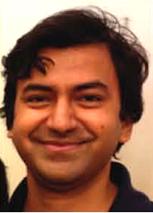









|
Title of Talk Modelling the dynamics of chemical noise in yeast cell cycle
Abstract A population of genetically identical cells exposed to same conditions shows significant cell-to-cell variation in characteristics. This cell-to-cell variability is linked to stochasticity in gene expression.Statistical physical models of gene expression indicate that due to low cellular abundances of various molecular species,the rates ofvarious biochemical reactions become discrete function of time, leading to noisy protein production over time. In order to understand the dynamics and consequence of noise, one has to make model for the whole cell. But the theoretical studies of chemical noise in cellular systems have mostly been concentrated on a single gene or a small genetic network. Towards this, we have recently built a mathematical model of yeast cell cycle control network to understand/predict the outcome of noise in various properties of cell cycle, e.g., cycle times, cell size at birth and division, durations in various phases of the cell cycle etc. The simulated results from the model compare favorably with the behavior of individual yeast cells observed experimentally. Our model provides understanding on how the cell cycle regulatory network works more or less accurately under the stochastic fluctuations of proteins and mRNAs.
References: 1. David A. Ball, Neil R. Adames, Nadine Reischmann, Debashis Barik, Christopher T. Franck, John J. Tyson, Jean Peccoud, Cell Cycle 2013, 12, 3203 2. Debashis Barik, William T. Baumann, Mark R. Paul, BelaNovak, John J Tyson, Mol. Sys. Biol. 2010, 6, 405 3. Orsolya Kapuy, Debashis Barik, Maria R. D. Sananes, John J. Tyson, Bela Novak, Prog. Biophys. Mol. Biol. 2009, 100, 47 |
|
Debashis Barik, Assistant Professor
School of Chemistry, University of Hyderabad, Gachibowli, Hyderabad, 500046, AP, INDIA e-mail: dbariksc@uohyd.ac.in
Selected Publications 1. Debashis Barik, William T. Baumann, Mark R. Paul, Bela Novak, John J Tyson, Mol. Sys. Biol. 2010, 6, 405 2. Debashis Barik, Mark R. Paul, William T. Baumann, Yang Cao, John J. Tyson, Biophys. J. 2008, 95, 3563 3. Debashis Barik, Euro. Phys. J. B 2007, 56, 229 4. Debashis Barik, Europhys. Lett. 2006, 75, 42 5. Debashis Barik, Suman K. Banik, Deb Shankar Ray, J. Chem. Phys. 2003, 119, 680 |

